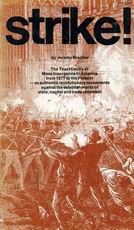
Strike!
The True History of Mass Insurgence from 1877 to the Present
Brecher, Jeremy
Publisher: Straight Arrow Books, San Francisco, USA
Year First Published: {12450 Strike! STRIKE The True History of Mass Insurgence from 1877 to the Present Brecher, Jeremy Straight Arrow Books San Francisco USA A history-from-below that brings to light strikes as authentic revolutionary movements against the establishments of state, capital, and trade unionism. 1972 1997 329pp BC12450-Strike.jpg B Book 0-89608-569-4 331.892 Brecher writes: The mains actors in the story are ordinary working people. Most historians, whether radical or conservative, tend to consider ordindary workers a mere "rank and file," controlled and directed by unions and labor leaders. Strikes are presumably the work of these organizations and leaders. I have found, on the contrary, that far from fomenting strikes and rebellions, unions and labor leaders have most often striven to prevent or contain them, while the drive to extend them has generally come from a most undocile "rank and file." Indeed, the most important lessons I learned in preparing this book is the extent to which ordinary working people, acting on their own, have through the decades thought, planned, drawn lessons from their own experiences, organized themselves, and taken action in common. Much of the time these abilities have had no chance for expression; they were suppressed in a society which believed ordindary working people should distrust one another and obey their superiors. But when "looking out for number one" and "getting along by going along" no longer worked, people discovered that together they had powers they never suspected.
<br>
<br>This is important because the greatest problem we face today is our powerlessness. It underlies every particular problem we face: war, pollution, racism, brutality, injustice, insecurity, and the feeling of being trapped, our lives wasting away, pushed around by forces beyond our control. The source of all these problems is not some cruel decree of fate; every one of them results from the fact that we do not control the life or our own society. The fundamental problem we face -- and the key to solving the more particular problems -- is to transform society so that ordinary people control it.
<br>
<br>
<br>Table of Contents:
<br>
<br>Preface
<br>
<br>Part I: The History of American Strikes
<br>Prologue
<br>Chapter 1: The Great Upheaval
<br>Chapter 2: May Day
<br>Chapter 3: "The Ragged Edge of Anarchy"
<br>Chapter 4: Nineteen Nineteen
<br>Chapter 5: Depression Decade
<br> "Don't Starve - Fight"
<br> Nineteen Thirty Four
<br> Sitdown
<br>Chapter 6: Postscript the War and Post-war Strike Wave
<br>
<br>Part II: The Significance of American Strikes
<br>Chapter 7: The Significance of Mass Strikes
<br> The Mass Strike Process
<br> The Course of Mass Strikes
<br> The Containment of Mass Strikes
<br>Chapter 8: The Current Scene
<br>Chapter 9: From Mass Strike to New Society
<br>Afterword: A Challenge to Historians CX6590 0 true true false CX6590.htm [0xc0009f1620 0xc000f5a1e0 0xc00196dce0 0xc001a35890 0xc001c78900 0xc001f0e8d0 0xc001f3f5f0 0xc00020d0e0 0xc00022c8a0 0xc000293890 0xc0002bbda0 0xc00015c810 0xc0000edf20 0xc0003aa180 0xc0001f8960 0xc000969950 0xc000bc5770 0xc000be0090 0xc00067ce10 0xc00083cde0 0xc00024efc0 0xc000282cc0 0xc00067a540 0xc000819e60 0xc0009b0c90 0xc0006a4720 0xc00157d0e0 0xc0015d6390 0xc001ad4450 0xc001dd5cb0 0xc002232570 0xc002280db0 0xc0023bb6b0 0xc0024c6690 0xc00035df20 0xc0004df3b0 0xc000757f80 0xc0008e33b0 0xc00099e2a0 0xc000a42720 0xc000a42ea0 0xc000a9c5d0 0xc001919410 0xc001c9a870 0xc002220ea0 0xc002275440 0xc0026d29c0 0xc00283d9b0 0xc00284fe60 0xc002874e40 0xc00289dc20 0xc0028df710 0xc002932ba0 0xc002960330 0xc002976330] Cx}
Year Published: 1997
Pages: 329pp ISBN: 0-89608-569-4
Dewey: 331.892
Resource Type: Book
Cx Number: CX6590
A history-from-below that brings to light strikes as authentic revolutionary movements against the establishments of state, capital, and trade unionism.
Abstract:
Brecher writes: The mains actors in the story are ordinary working people. Most historians, whether radical or conservative, tend to consider ordindary workers a mere "rank and file," controlled and directed by unions and labor leaders. Strikes are presumably the work of these organizations and leaders. I have found, on the contrary, that far from fomenting strikes and rebellions, unions and labor leaders have most often striven to prevent or contain them, while the drive to extend them has generally come from a most undocile "rank and file." Indeed, the most important lessons I learned in preparing this book is the extent to which ordinary working people, acting on their own, have through the decades thought, planned, drawn lessons from their own experiences, organized themselves, and taken action in common. Much of the time these abilities have had no chance for expression; they were suppressed in a society which believed ordindary working people should distrust one another and obey their superiors. But when "looking out for number one" and "getting along by going along" no longer worked, people discovered that together they had powers they never suspected.
This is important because the greatest problem we face today is our powerlessness. It underlies every particular problem we face: war, pollution, racism, brutality, injustice, insecurity, and the feeling of being trapped, our lives wasting away, pushed around by forces beyond our control. The source of all these problems is not some cruel decree of fate; every one of them results from the fact that we do not control the life or our own society. The fundamental problem we face -- and the key to solving the more particular problems -- is to transform society so that ordinary people control it.
Table of Contents:
Preface
Part I: The History of American Strikes
Prologue
Chapter 1: The Great Upheaval
Chapter 2: May Day
Chapter 3: "The Ragged Edge of Anarchy"
Chapter 4: Nineteen Nineteen
Chapter 5: Depression Decade
"Don't Starve - Fight"
Nineteen Thirty Four
Sitdown
Chapter 6: Postscript the War and Post-war Strike Wave
Part II: The Significance of American Strikes
Chapter 7: The Significance of Mass Strikes
The Mass Strike Process
The Course of Mass Strikes
The Containment of Mass Strikes
Chapter 8: The Current Scene
Chapter 9: From Mass Strike to New Society
Afterword: A Challenge to Historians
Subject Headings


